
KwaZulu-Natal is a province of South Africa that was created in 1994 when the Zulu bantustan of KwaZulu and Natal Province were merged. It is located in the southeast of the country, enjoying a long shoreline beside the Indian Ocean and sharing borders with three other provinces, and the countries of Mozambique, Eswatini and Lesotho. Its capital is Pietermaritzburg, and its largest city is Durban. It is the second-most populous province in South Africa, with slightly fewer residents than Gauteng.
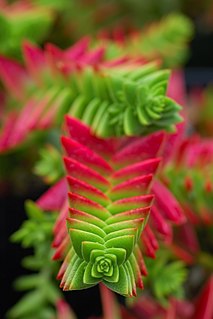
Crassula is a genus of succulent plants containing about 200 accepted species, including the popular jade plant. They are members of the stonecrop family (Crassulaceae) and are native to many parts of the globe, but cultivated varieties originate almost exclusively from species from the Eastern Cape of South Africa.
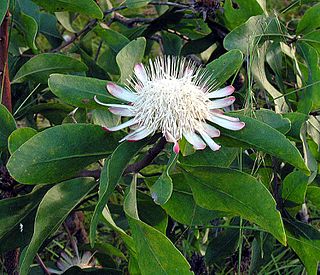
Protea gaguedi is a species of tree which belongs to the genus Protea.

Protea comptonii, also known as saddleback sugarbush, is a smallish tree of the genus Protea in the family Proteaceae. It is found in South Africa and Eswatini.

The KwaZulu-Natal Legislature is the primary legislative body of the South African province of KwaZulu-Natal. It is unicameral in its composition, and elects the premier and the provincial cabinet from among the members of the leading party or coalition in the parliament.

Agapanthus praecox is a popular garden plant around the world, especially in Mediterranean climates. It is native of Natal and Cape of Good Hope in South Africa, local names include agapant, bloulelie, isicakathi and ubani. Most of the cultivated plants of the genus Agapanthus are hybrids or cultivars of this species. It is divided into three subspecies: subsp.praecox, subsp. orientalis and subsp. minimus.

Isoglossa woodii, commonly known as buckweed, is a monocarpic shrub of the family Acanthaceae, growing up to 4 m tall. It grows in colonies in coastal forest areas of KwaZulu-Natal and marginally into Eastern Cape, South Africa.

Euclea racemosa is a small to medium-sized evergreen tree that is indigenous to the Indian Ocean coast of Africa from Egypt to South Africa, as well as in Comoros, Oman and Yemen.

Crassula marnierana, common name Jade Necklace or Chinese Pagoda, is a species of succulent in the genus Crassula belonging to the family Crassulaceae.

Eucomis bicolor, the variegated pineapple lily or just pineapple lily, is a bulbous species of flowering plant in the family Asparagaceae, subfamily Scilloideae, native to Southern Africa. The pale green, purple-margined flowers are arranged in a spike (raceme), topped by a "head" of green leaflike bracts. It is cultivated as an ornamental bulbous plant, although its flowers have an unpleasant smell, attractive to the main pollinators, flies.

Crassula capitella, is a perennial succulent plant native to southern Africa.
Carex rainbowii is a species of sedge found in the understorey of Afromontane forests in the Drakensberg Mountains of South Africa. It had previously been misidentified as introduced populations of Carex sylvatica, but was published as a new species in 2013.

Crassula ovata, commonly known as jade plant, lucky plant, money plant or money tree, is a succulent plant with small pink or white flowers that is native to the KwaZulu-Natal and Eastern Cape provinces of South Africa, and Mozambique; it is common as a houseplant worldwide. Much of its popularity stems from the low levels of care needed; the jade plant requires little water and can survive in most indoor conditions. It is sometimes referred to as the money tree; however, Pachira aquatica also has this nickname.

Crassula nudicaulis is a succulent plant native to South Africa, and Lesotho.
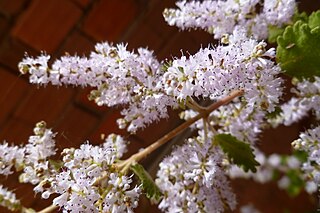
Tetradenia riparia is a species of flowering plant native to southern Africa. It belongs in the mint and sage family Lamiaceae. It is occasionally referred to as misty plume bush and is commonly used as a decorative garden plant due to its flowers when in full bloom. Tetradenia means 'four glands' and riparia translates to 'growing on banks of rivers'. This species was first described by botanists (Hochst.) Codd in 1983.

Crassula brevifolia is a succulent plant native to the arid western edge of South Africa as well as southern Namibia.
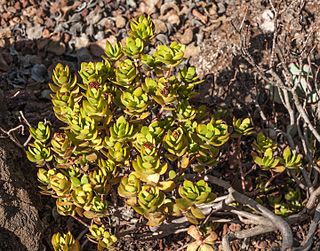
Crassula cultrata is a succulent plant native to the southern parts of South Africa.
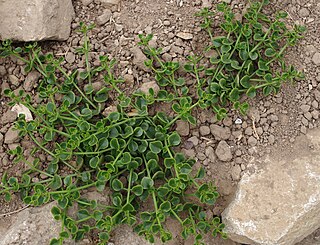
Crassula spathulata is a creeping, succulent ground-cover, indigenous to the Eastern Cape Province and southern KwaZulu-Natal, South Africa, where it is found in leaf-litter on rocky ridges, often around the edges of forests.

Crassula pellucida is a creeping, succulent ground-cover, or low-growing, spreading succulent shrub, indigenous to South Africa.
Protea dracomontana, the Nyanga protea or the Drakensberg sugarbush, is a flowering plant that belongs within the genus Protea. The plant is found in the Eastern Cape, Lesotho, KwaZulu-Natal and the escarpment of the Free State, as well as eastern Zimbabwe. In Zimbabwe this species is only known from a disjunct subpopulation confined to the summit of Mount Nyangani.


















